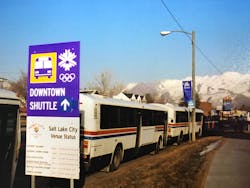UTA Remembers the 2002 Winter Olympics
UTA Light Rail General Manager Jeff LaMora had spent more than a year working with fellow employees, other transportation agencies, cities and counties to try to create enough Park & Ride space to accommodate people taking shuttles into the city. Despite media predictions of “doom and gloom and lots of gridlock,” LaMora said that the system worked exceptionally well thanks to careful planning from all involved agencies.
“It was two of the best weeks that I’d ever had in my career,” LaMora said.
He spent the games assisting shuttle services under the old North Temple viaduct, far from the glitz and glamour of the actual events. Despite missing most of the Olympics while working 14-hour days, LaMora said the weeks still carry many happy memories.
“The whole event was just kind of special,” he said. “Everybody that you talk to — every person, no matter where they were, had such a great time.”
The 17-day event brought between 70,000 and 80,000 spectators into the city every day. According to a 2003 report, 2.52 million boardings were recorded on public transportation during the games – 1.7 million on TRAX, and the remainder on shuttle buses provided by UTA and the Park City Transit System. Dallas Area Rapid Transit loaned bright yellow light rail vehicles to supplement UTA cars on the new, two-line TRAX system, and 1,200 buses were borrowed from other transit agencies.
UTA Manager of Project Development and Systems Planning Hal Johnson said the organization’s administrative office operated on a skeleton staff as employees spent their days — and nights — ensuring that event transportation ran smoothly.
“It was just a friendly, collegial kind of atmosphere every night,” he said. “It was a positive experience and really memorable to me, even though we didn’t see any of the events because we were out providing service at the time. We’d start at one in the afternoon and wouldn’t be done until 2 a.m.”
UTA Senior Legal Counsel Bart Simmons helped create transportation contracts prior to the games and manned Courthouse Station during the events. Most visitors were friendly and courteous, he said, although one unexpected event still stands out in his memory.
Near the end of the Olympics, police shut down a Gallivan Center beer garden early due to unruly crowds. Angry, drunk revelers ran down Main Street, dodging cross-street traffic and leaving a trail of debris in their wake.
Simmons helped usher riders waiting at Courthouse Station safely out of the way while the crowd ran past, then stood amazed as military-style helicopters took flight all around the Grand America Hotel where dignitaries like Dick Cheney stayed during the events.
“It was unbelievable — like something out of the movie Black Hawk Down,” he said.
Fortunately, the crowd dispersed without incident and became just a minor episode in what was, at the time, the best-attended and most financially successful Winter Olympics in history. Despite the long hours and what he remembers as “the brutal cold,” Simmons said the experience will always stand out in his mind.
“I wouldn’t trade it for anything,” he said.
